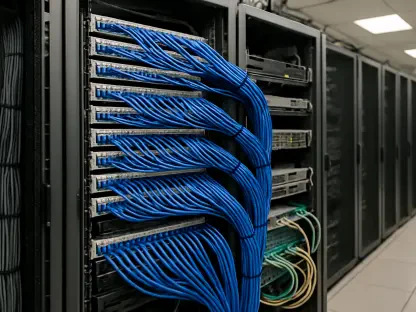Ensuring optimal network performance is crucial in today’s digital age, where reliability and efficiency are paramount. Network performance can significantly impact user experience and business operations. Slow or unreliable network performance can create massive disruptions, decreasing productivity and damaging customer satisfaction. To diagnose and resolve these issues, network leaders must prioritize specific metrics that provide insight into network health. A thorough understanding of these key metrics is essential for maintaining robust and efficient networks, thus ensuring seamless and reliable service for users.
The Importance of Uptime
Network uptime is the most critical metric and forms the backbone of all other performance indicators. High uptime ensures that the network is reliable and operational, directly impacting productivity and customer satisfaction. Network downtime can lead to halted operations, causing significant losses in business revenue and customer trust. Therefore, achieving high uptime is crucial to maintaining uninterrupted access to resources and ensuring smooth business operations. The emphasis on uptime was further highlighted by Jeff Mains, founder of the Champion Leadership Group, who shared a real-world example to illustrate its importance.
Mains shared an example involving a healthcare client struggling with network reliability, initially standing at 98 percent. Through implementing redundancy protocols and better monitoring, the client was able to improve their reliability to 99.99 percent, significantly boosting user satisfaction and trust. This underscores the pivotal role of even slight improvements in uptime, demonstrating how incremental reliability enhancements can lead to remarkable benefits in overall user experience. Ensuring high network uptime should thus be a top priority for network administrators looking to maximize both operational efficiency and customer retention.
The Impact of Packet Loss
Packet loss is another vital metric that provides substantial insight into network performance. When data fails to reach its destination, marked by high packet loss rates, users can experience degraded quality in voice and video communications, along with sluggish file transfers. This is particularly problematic for bandwidth-heavy applications, where consistent and reliable data transfer is essential. The implications of packet loss can be likened to a leaky pipe, where inefficiencies become apparent and negatively impact overall network performance. Anbang Xu, founder of JoggAI, strongly emphasizes the detrimental effects of packet loss on network reliability.
The silent yet significant impact of packet loss on sensitive applications such as VoIP (Voice over Internet Protocol) and streaming services was further corroborated by Vladislav Bilay, a DevOps engineer. Prompt detection and resolution of packet loss issues are critical to maintaining the integrity and stability of such communications. High-quality interactions and the smooth functionality of bandwidth-intensive applications rely heavily on mitigating packet loss. Continuous monitoring and addressing packet loss are imperative to ensuring optimal network performance and delivering consistent and reliable user experiences.
Understanding Latency
Latency is a critical metric impacting user experiences in real-time communications and collaborations. Delays caused by latency can disrupt activities such as video streaming or live calls, where every millisecond matters. In today’s fast-paced digital interactions, even slight delays can lead to frustration and reduced efficiency. Monitoring latency is essential for identifying and resolving potential issues before they escalate into significant problems that impact user experience. Anbang Xu stresses the importance of considering latency alongside other metrics to get a comprehensive picture of network health.
Xu advocates for combining latency and packet loss metrics to attain a holistic view of network responsiveness and stability. By monitoring both, network administrators can pinpoint underlying issues and better understand the overall performance. It is essential to consistently keep an eye on latency to avoid disruptions in real-time communications. This comprehensive approach not only facilitates quicker resolution of potential problems but also helps in proactive management, ensuring that the network remains robust and effective in all operational circumstances.
Additional Performance Metrics
Beyond uptime, packet loss, and latency, other performance metrics are equally essential for a thorough analysis of network health. Metrics such as throughput, error rates, and overall availability offer critical insights that help administrators make informed decisions regarding network upgrades and maintenance. Evaluating these metrics collectively provides a full-spectrum analysis of network performance, enabling the anticipation of potential shortcomings before they affect overall functionality. Gaurav Kataria, a Meta software engineer, emphasizes the importance of these additional metrics, advocating for a comprehensive approach to network evaluation.
Kataria points out that understanding these metrics collectively can unveil potential issues which might be overlooked if considered individually. For instance, throughput measures the amount of data transferred over the network, which directly impacts perceived network speed. Error rates can indicate underlying issues in data transmission that, if left unaddressed, might escalate into more significant problems. Overall availability captures the network’s readiness to serve users at all times. A holistic view provided by these metrics aids in preemptively identifying and addressing weak points, ensuring the network consistently operates at peak levels.
The Critical Role of MTTD
Mean Time to Detection (MTTD) measures the time taken to identify network issues, an often-overlooked yet critical metric. Timely detection and resolution of problems can drastically reduce downtime and latency spikes, ensuring a seamless user experience. Jeff Mains shares the importance of this metric, recounting how AI-driven monitoring systems helped a financial sector client detect and rectify issues within minutes, rather than hours. This intervention significantly reduced client churn caused by latency issues, underlining the importance of swift detections.
By focusing on MTTD, network teams can better anticipate and swiftly mitigate problems, avoiding prolonged disruptions. This proactive approach is vital for maintaining network reliability and ensuring that users experience minimal disruptions in service. Swift detection and resolution not only improve network efficiency but also build trust with users who rely on uninterrupted service. MTTD is an integral metric that encapsulates the efficiency and responsiveness of a network team’s ability to maintain optimal performance and reliability.
Metrics and User Behavior
In today’s digital landscape, maintaining top-notch network performance is vital, as both reliability and efficiency are highly valued. Network performance directly influences user experience and the smooth running of business operations. When network performance is slow or unreliable, it can lead to significant disruptions, hampering productivity and harming customer satisfaction. To effectively diagnose and address these issues, network leaders must focus on specific metrics that shed light on the health of the network. Gaining a comprehensive understanding of these vital metrics is crucial for sustaining strong and efficient networks. By doing so, businesses can ensure seamless and dependable service for their users, minimizing interruptions and maintaining high levels of satisfaction. In essence, prioritizing these key metrics not only helps in troubleshooting existing network problems but also in preventing potential issues, thus supporting overall organizational goals and enhancing user experiences in the long run.









